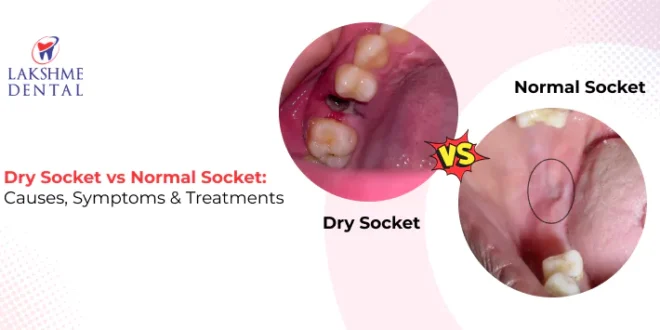Introduction
After a tooth extraction, the healing process involves the formation of a blood clot at the extraction site, which protects the exposed bone and nerve endings. However, in some cases, the blood clot may become dislodged or dissolve, leading to a condition known as dry socket. Understanding the distinction between a dry socket and a healthy (normal) socket is essential for identifying potential complications and seeking timely treatment. In this guide, we will explain the symptoms of both conditions, explore their differences, and offer insight into how to manage and prevent dry socket effectively.
What is a Normal Socket?
Definition and Healing Process
A normal socket refers to the empty space left behind after a tooth extraction. In a healthy socket, the body forms a blood clot over the exposed bone and nerve, serving as a protective layer that promotes tissue healing.
Over the next few days, the following signs of healthy healing are expected:
- Minimal pain that gradually reduces over time.
- Swelling or tenderness, which decreases within a few days.
- Formation of new gum tissue as part of the healing process.
- Absence of bad breath or an unpleasant taste in the mouth.
Timeline for Recovery
The initial healing stage for a healthy socket lasts approximately 1 to 2 weeks, though complete recovery may take longer, especially for molar extractions. Following proper aftercare instructions, such as avoiding vigorous rinsing and not using straws, ensures smooth healing.
What is a Dry Socket?
Definition and Causes
A dry socket, also called alveolar osteitis, occurs when the protective blood clot is lost or fails to form. As a result, the underlying bone and nerve endings become exposed to air, food, and bacteria, leading to severe discomfort and delayed healing. Common causes include:
- Smoking or using tobacco products.
- Poor oral hygiene following the procedure.
- Forceful spitting or rinsing too soon after extraction.
- Use of straws, which creates suction and dislodges the clot.
Symptoms: Dry Socket vs Normal Socket
Normal Socket Symptoms
In a healthy socket, discomfort is normal but manageable, and pain decreases over time. Typical symptoms include:
- Mild pain that subsides gradually.
- Swelling that peaks within 48 hours and reduces thereafter.
- New tissue forming to cover the socket.
- Absence of an unpleasant odor or taste.
Dry Socket Symptoms
A dry socket, by contrast, presents distinct and severe symptoms that require immediate attention. The signs include:
- Sharp, radiating pain that extends to the ear, eye, or temple.
- Visible bone at the extraction site, with no blood clot present.
- Foul odor or a bad taste in the mouth.
- Prolonged discomfort that intensifies instead of improving.
Dry socket typically begins within 2-4 days after the extraction, unlike a normal socket where pain diminishes quickly.
How to Treat Dry Socket
Professional Treatment
If a dry socket develops, a dentist or oral surgeon should provide treatment to alleviate pain and promote healing. Standard treatments include:
- Socket Irrigation: Cleaning the site to remove food particles or debris.
- Medicated Dressings: Packing the socket with a soothing paste or gauze.
- Pain Relief: Prescribing analgesics or over-the-counter medication.
Regular follow-ups ensure that the site heals properly and complications are avoided.
Home Care Tips
In addition to professional treatment, practicing self-care helps reduce discomfort:
- Avoid smoking or using straws.
- Rinse gently with warm saline solution to keep the socket clean.
- Stick to soft foods and avoid chewing near the extraction site.
How to Prevent Dry Socket
Follow Post-Extraction Instructions
Prevention is key to avoiding dry socket. Adhering to the aftercare instructions provided by your dentist is essential. This typically includes avoiding physical activity for 24 hours, refraining from drinking through straws, and not rinsing the mouth aggressively.
Maintain Good Oral Hygiene
Keeping your mouth clean while being gentle around the extraction site can prevent infections and promote healthy healing. Using antiseptic mouthwash, if recommended, helps reduce bacteria in the mouth.
Conclusion
Understanding the difference between a dry socket and a healthy socket is essential for recognizing potential complications early. While mild discomfort is normal in the healing process, sharp pain, a foul odor, or a visible bone indicate that professional care is needed for a dry socket. Adhering to post-extraction care instructions can significantly reduce the risk of developing this painful condition. With proper care and timely treatment, you can ensure a smooth recovery and avoid further dental complications.
Are you passionate about sharing your insights and expertise? We invite you to write for us! Whether you’re a seasoned writer or just starting out. We’re looking for fresh perspectives on a variety of topics, from lifestyle and wellness to technology and travel.
 Lifeyet News Lifeyet News
Lifeyet News Lifeyet News





